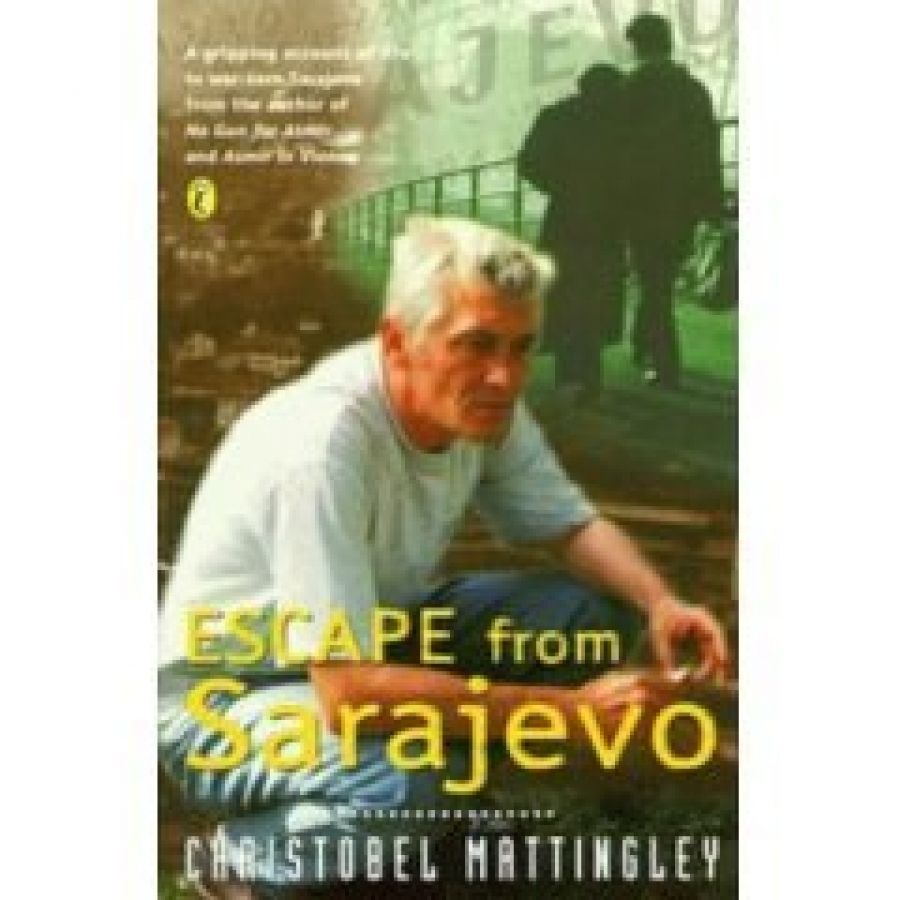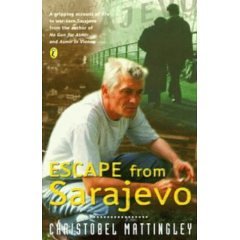
- Free Article: No
- Contents Category: Non-fiction
- Review Article: Yes
- Article Title: Dedicated to Peace
- Online Only: No
- Custom Highlight Text:
In an interview in December 1995, author Christobel Mattingley said that ‘from the beginning’ she felt ‘that writing was my way of giving something back, helping other people to grow and expand and make the world a better place’. Her first book, No Gun for Asmir, about Bosnian refugee child Asmir and his family, had a remarkable effect worldwide, both emotionally and practically. The book was used by many people to exert pressure on various bureaucracies to allow Muris, Asmir’s father, to leave Bosnia. Now we have the story of Muris himself, in Escape from Sarajevo – a book Christobel Mattingley has dedicated in part ‘to all who teach children to make peace’.
- Book 1 Title: Escape from Sarajevo
- Book 1 Biblio: Puffin Books, $11.95 pb, 266 pp
- Book 1 Cover Small (400 x 600):

- Book 1 Cover (800 x 1200):

Inevitably, there is some overlapping with the earlier books, as we see some of the same events from the point of view of Asmir’ s father. This, however, does not detract from any of the books; it helps indeed, to round out the story. This is particularly true of the emotional dimension, as previously we could only guess at the impact the separation would have on Asmir’s father. Now we have a graphic illustration of that effect, through Mattingley’ s narrative and through the letters to his family which Muris has allowed to be published in this book. He believed strongly in the importance of surviving to tell what had really happened in Sarajevo.
As with the earlier books, perhaps one of the most important and powerful things about Escape from Sarajevo, is the starkness with which it makes the reader realise the impact of war on the lives of ordinary people. Life for those left behind could well be as difficult, and often more fraught with danger, than for those who are refugees. All the basic necessities we take for granted in Australia were no longer available to Muris and the civilians of Sarajevo – water, fuel, heating, lighting and regular food. One of the most poignant moments in the book is when Muris and his mother harvest and eat the one tomato they have managed to grow from some seeds sent in a humanitarian parcel. This tomato is made to last for three days, as each of them savours just one slice a day.
There are, too, amazing glimpses of individual courage – even beyond the courage needed to live in a city constantly bombarded and where there is ever-present danger from sniper-fire.
Early in the war the leading cellist of the Sarajevo Opera orchestra had sat, dressed in his tails, in the street on the site of a massacre, day after day for twenty-two days playing a requiem to its victims.
There are too instances described of people helping Muris at great personal danger.
But this is no hagiography. We hear too about instances of theft from food parcels, of bandits preying on refugee buses, of petty officials needing to be bribed. This helps to build up the whole picture and perhaps reinforces the full horror of the war in Bosnia, something which is beyond the comprehension of most Australians, despite the nightly glimpses we had of it on television.
Also important is the description of the effect of war on the individual. For young readers it might be especially striking that an adult, Asmir’s idolised and apparently invincible father, could be afraid and depressed. The ongoing psychological effects of the separation and living through the siege are graphically demonstrated in a number of incidents after Muris’s escape. For an adult reader, one of the most heart-rending images in the book is of Muris, finally in Zagreb on his way to Vienna, walking along the street and seeing, in a shop window, an old, stooped, white-haired man in a baggy suit and realising, with a shock, that it is himself.
The book is set out chronologically, describing incidents that happened and the thoughts and feelings of Muris and his mother during the twenty-two months he remained in Sarajevo after the escape of his wife and family. This layout has an almost paradoxical effect, as it unfolds quite slowly and yet we realise just how many, often quite dreadful, things have happened in a relatively short time. The additional pieces of the book – Muris’s own foreword and afterword, and the chronology of the history of Sarajevo for example – are interesting and add depth to the whole.
Books are seen throughout this story as a symbol of civilisation, the one thing Muris finds himself unable to burn, even in the depths of winter. As the reviewer in The Canberra Times has said of Asmir in Vienna, this too ‘is a book with the power to change the way its readers view the world’. In his foreword, Muris expresses his frustration at being unable to describe what happened and his emotional state as well as he would like. Nonetheless, with Christabel Mattingley’s help, he has told a moving and heartwarming story. Together they show that the pen can be mightier than the sword.


Comments powered by CComment